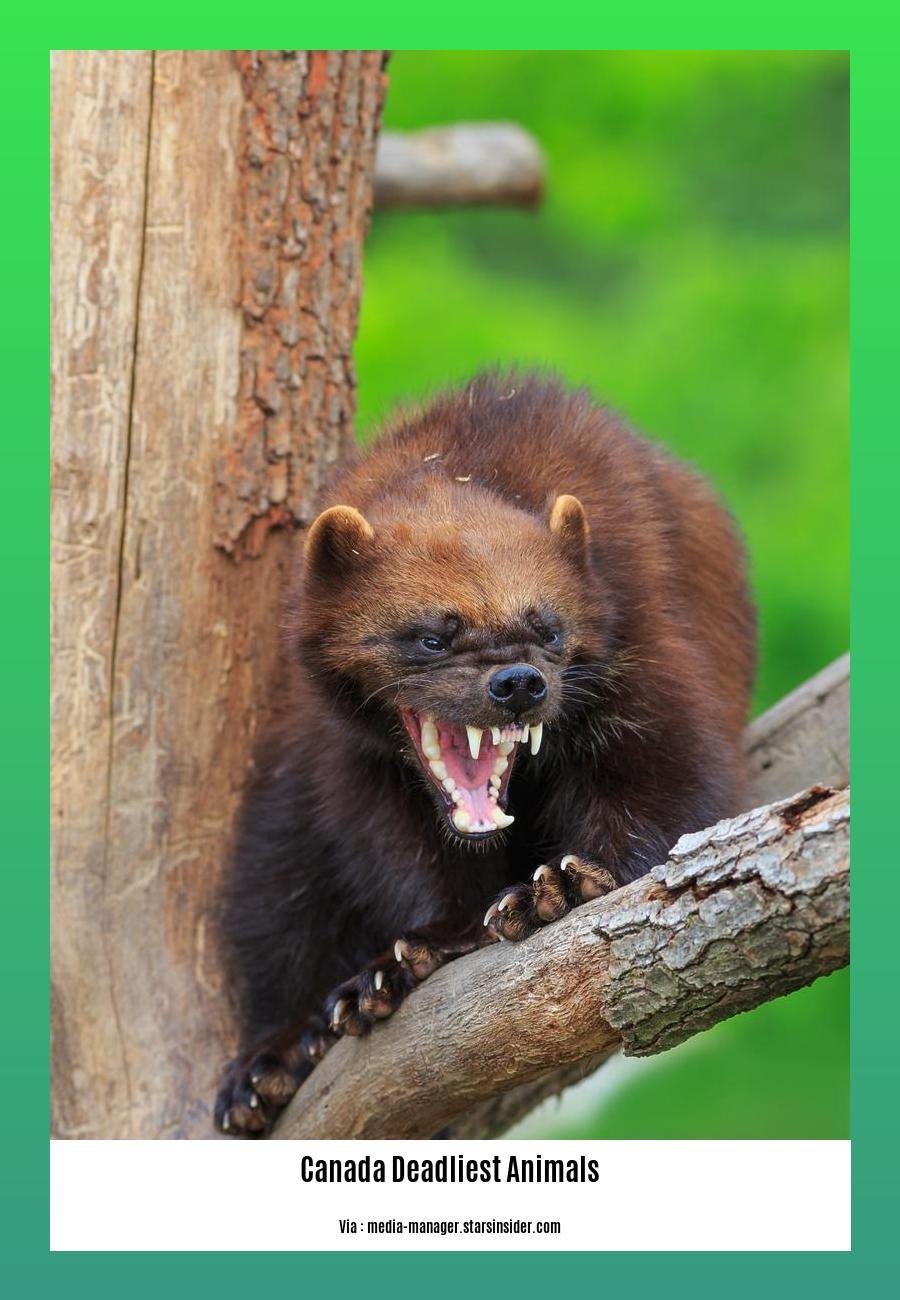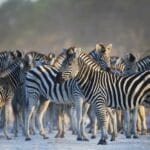Unmasking the Dangers: In-Depth Exploration of Canada’s Deadliest Animals takes readers on a thrilling journey through the wild side of Canada’s ecosystem. From the shadows of dense forests to the depths of icy waters, this captivating article delves into the intriguing world of Canada’s deadliest creatures. With a focus on both the awe-inspiring beauty and the potential dangers they pose, we unveil the hidden stories behind these formidable beings, shedding light on their vital role in maintaining the delicate balance of nature. Join us as we uncover the secrets of Canada’s most lethal inhabitants and gain a deeper understanding of their significance within the country’s diverse wildlife.
Key Takeaways:
- Canada is home to several dangerous animals, including moose, polar bears, grizzly bears, black bears, black widow spiders, prairie rattlesnakes, cougars, gray wolves, orcas, and coyotes.
- Moose, the largest deer species, are responsible for many vehicle accidents in Canada.
- Polar bears, similar in size to grizzly bears, are considered one of the most dangerous animals in Canada, although they typically only attack humans when provoked or hungry.
- Grizzly bears are known for their deadly nature in Canada.
- Black bears can also pose a threat to humans in Canada.
- Black widow spiders are venomous and found in Canada.
- Prairie rattlesnakes are poisonous snakes found in southwestern Canada, especially in Alberta.
- Cougars and gray wolves are both dangerous animals in Canada, with the ability to run at high speeds.
- Orcas, or killer whales, are powerful marine predators in Canada.
- Despite being smaller, coyotes are still considered dangerous in Canada.
Canada’s Deadliest Animals: Unveiling Nature’s True Predators

Canada’s vast and untamed wilderness is home to a myriad of creatures, both captivating and deadly. While the country may be known for its breathtaking landscapes and diverse ecosystem, it also harbors some of the most dangerous animals. From massive moose to the formidable polar bear, these creatures command respect and invoke both fear and awe. In this article, we will embark on an in-depth exploration of Canada’s deadliest animals, shedding light on their behavior, habitat, and the risks they pose to humans.
Mighty Moose: More than Just a Majestic Creature
Standing tall as the largest species in the deer family, moose are a common sight in Canadian wilderness. With their imposing antlers and sturdy build, they command attention. Yet, beyond their majestic appearance, these gentle giants can pose a significant threat. Responsible for numerous vehicle accidents in Canada, moose collisions can result in severe injuries and fatalities. Striking them at high speeds can have devastating consequences, making it imperative to keep a watchful eye while traversing moose-populated areas.
The Arctic Predator: Polar Bears and the Perils of Survival
Venturing into Canada’s icy realms brings us face to face with the polar bear, a true icon of the North. Renowned for their remarkable adaptations to withstand extreme cold, these apex predators are also considered one of the most dangerous animals in Canada. While polar bears generally avoid humans, encounters can turn fatal if they feel provoked or perceive humans as potential prey. As climate change threatens their sea ice habitat, human-bear interactions become more frequent, emphasizing the need for caution and respect in their presence.
Grizzly Bears: The Fearsome Guardians of the Wild
When delving deep into the Canadian wilderness, the grizzly bear epitomizes raw power and primal instincts. With a reputation as one of the deadliest animals, encounters with these majestic beasts are not to be taken lightly. Possessing immense strength and sharp claws capable of disemboweling, grizzly bears command respect and distance. Understanding their behavior, respecting their habitat, and employing proper safety precautions are essential to sharing space harmoniously with them.
The Shadowy Threats: Black Bears and Black Widow Spiders
While less aggressive than their grizzly counterparts, black bears should never be underestimated. These stealthy creatures roam Canada’s forests, often blending into the shadows. Although attacks on humans are rare, instances of aggression can occur, particularly when bears become habituated to human presence or food sources. Vigilance and adhering to established bear safety protocols are crucial to avoid potentially dangerous situations.
Transitioning into the realm of invertebrates, we encounter the venomous black widow spider. This arachnid species, known for its distinctive red hourglass mark, has made its presence known in Canada. With venom potent enough to cause severe reactions, it’s crucial to exercise caution in spider-dense habitats. While fatal bites are rare, familiarity with these eight-legged predators can help prevent unnecessary encounters and ensure a greater sense of security.
Slithering Danger: Prairie Rattlesnakes and the Call of the Wild
Moving further into the intricate tapestry of Canadian wildlife, we uncover the prairie rattlesnake, a venomous serpent found primarily in Alberta’s southwestern regions. Cloaked in camouflage, these snakes serve as an essential part of the ecosystem. However, encounters with humans can lead to potentially life-threatening situations. Maintaining distance, respecting their habitats, and recognizing their unique warning signal—the distinctive rattle—is essential in mitigating risks associated with these enigmatic reptiles.
Cougars and Gray Wolves: Eyes in the Shadows
Canada’s majestic wilderness harbors two formidable predators—the cougar and the gray wolf. These elusive creatures, lurking in the depths of forests, command respect and inspire fascination. With the ability to run at astonishing speeds, their hunting prowess is unparalleled. Although attacks on humans are rare, it is crucial to remain vigilant and informed about their behavior when exploring their territories. Understanding their ecological role and appreciating their existence within the intricate web of nature fosters a deeper connection with the environment they call home.
The Ocean’s Apex Predator: Orca
Venturing into Canada’s vast coastal waters, we encounter the orca, also known as the killer whale. These powerful marine predators rule the oceans with their intelligence and awe-inspiring presence. Yet, despite their reputation, attacks on humans are exceedingly rare. These magnificent creatures play a vital role in maintaining marine ecosystems, their hunting prowess shaping the delicate balance of life beneath the waves. Observing these apex predators from a safe distance ensures their natural behaviors go undisturbed, strengthening our understanding of these majestic marine creatures.
Beyond the Pack: Coyotes and the Importance of Coexistence
In the midst of Canada’s wilderness, the coyote, though smaller in stature, stands as a testament to nature’s adaptability and resilience. These skillful predators have learned to coexist alongside human communities. While they are generally reluctant to engage with humans, it is crucial to respect their boundaries and avoid encouraging behaviors that lead to conflicts. Maintaining a harmonious relationship promotes a greater appreciation for the complex interactions that shape Canada’s diverse ecosystem.
As we journey through the wilds of Canada, it becomes evident that the deadliest animals within its borders demand our respect and understanding. By embracing knowledge and fostering a deep appreciation for the intricacies of nature, we can navigate the majestic yet dangerous realms of Canada’s wildlife. Remembering that coexistence, education, and safety measures are paramount, we ensure that the delicate balance of this wilderness remains intact for generations to come.
Canada is known as the best country for immigrants to settle down and start a new life. Explore the opportunities and benefits that make Canada the best city for immigrants by clicking here.
If you are fascinated by Monet’s famous painting, “Bridge Over a Pond of Water Lilies,” you’d be amazed to learn about its characteristics. Experience the beauty and tranquility of this masterpiece by discovering its unique features here.
Interested in learning more about the mesmerizing “Bridge Over a Pond of Water Lilies” by Claude Monet? Get a detailed description of this remarkable piece of art here.
Grizzly Bears: Anatomy, Behavior, and Encounters with Humans

Grizzly bears, also known as brown bears belonging to the subspecies Ursus arctos horribilis, are fascinating creatures that inhabit the challenging wilderness of Canada. With their massive size, humped shoulders, and elevated forehead, they are easily recognizable. Their brownish to buff-colored fur adds to their majestic appearance.
Grizzly bears have developed unique behavioral adaptations that allow them to thrive in their environment. They are highly intelligent, curious, and possess excellent memory, especially when it comes to finding food sources. Their acute eyesight, exceptional senses of hearing and smell further aid them in their survival.
Contrary to their portrayal in the media as ferocious predators, grizzly bears are generally reclusive animals. They are active both during the day and at night, exhibiting versatility in their behavior. Sexual maturity is reached at around five years of age, and grizzly bears are predominantly solitary and territorial, except when mothers are caring for their cubs or when an abundant food source is discovered.
Encounters between grizzly bears and humans have been increasing in some areas. While grizzly bears typically avoid confrontation, it is crucial for humans to remain cautious and knowledgeable about their behavior and anatomy when encountering them. Understanding the bear’s behavior and knowing how to react during an encounter can greatly reduce the risk of harm.
It is essential to note that grizzly bears, like all wild animals, should be observed from a safe distance and should never be approached or fed. Preserving their habitat and showing respect towards their presence are crucial for the coexistence of grizzly bears and humans.
Key Takeaways:
- Grizzly bears, or brown bears, are characterized by their massive size, humped shoulders, and elevated forehead. They have brownish to buff-colored fur.
- Grizzly bears are intelligent, curious, and possess excellent memory, particularly for locating food sources. They have sharp senses of hearing, smell, and eyesight.
- Unlike their portrayal in the media, grizzly bears are generally reclusive animals. They are active both during the day and at night and reach sexual maturity around five years of age.
- Encountering grizzly bears requires caution and knowledge of their behavior and anatomy. Maintaining a safe distance, avoiding approaches, and never feeding them are fundamental precautions.
- Preserving their habitat and respecting their presence are vital for the coexistence of grizzly bears and humans.
Sources:
- Britannica: Grizzly Bear
- Western Wildlife Outreach: Grizzly Bear Behavior
Eastern diamondback rattlesnakes: Venomous reptiles of Canada
Key Takeaways:
– The eastern diamondback rattlesnake is North America’s longest and heaviest venomous snake, known for its iconic rattle and venomous bite.
– It is the largest rattlesnake species in North America, with a diamond-shaped pattern of scales on its back.
– Endemic to the Southeastern United States, it can be found from southeastern North Carolina to the Florida Keys.
– The eastern diamondback rattlesnake inhabits upland dry pine forests, pine, and palmetto flatwoods, sandhills, and coastal maritime areas.
– It frequently shelters in gopher and tortoise burrows and emerges in the early morning or evening to hunt for prey.
Canada is home to a wide range of fascinating and often dangerous animals, including the eastern diamondback rattlesnake. Although this particular species may not be found within Canada’s borders, it is worth exploring its characteristics and understand the role it plays in the wider North American ecosystem.
The eastern diamondback rattlesnake holds the title for North America’s longest and heaviest venomous snake. With an average length of 3-6 feet, some adults might reach up to an impressive 8 feet long. Its distinctive rattle and venomous bite make it an iconic and potentially deadly creature.
While the eastern diamondback rattlesnake primarily resides in the Southeastern United States, its significance extends beyond geographical boundaries. As the largest rattlesnake species in North America, its presence showcases the remarkable diversity within the continent’s reptile population.
Recognizable by its diamond-shaped pattern of scales, this reptile navigates its natural habitat with ease. The eastern diamondback rattlesnake prefers upland dry pine forests, pine, and palmetto flatwoods, sandhills, as well as coastal maritime areas. Its adaptability enables it to thrive in various ecosystems, demonstrating both resilience and survival instincts.
Frequently, the eastern diamondback rattlesnake seeks shelter by tunneling into gopher and tortoise burrows. These underground hideouts provide protection from predators and help regulate body temperature. With such strategic retreat spots, the eastern diamondback rattlesnake emerges during the early morning or evening to hunt for prey.
It is important to note that while we explore the wonders of Canada’s ecosystem, the eastern diamondback rattlesnake is not endemic to the country. Nonetheless, understanding the relevance of this venomous reptile on a larger scale enhances our appreciation for North America’s rich biodiversity.
Sources:
– Eastern diamondback rattlesnake – Smithsonian’s National Zoo
– Eastern diamondback rattlesnake – Wikipedia
Killer whales: Apex predators of the Canadian waters
Canada’s waters are home to some of the most fascinating and deadly creatures, and among them, killer whales reign supreme as apex predators. With their incredible power and presence, these majestic creatures play a vital role in the marine ecosystem.
Killer whales, or orcas, have been confirmed as apex predators in the Canadian waters and have earned their reputation as masters of the ocean. They are known to prey upon nearly every large animal species in the ocean, showcasing their ability to adapt and thrive in diverse environments (Yahoo News Canada).
One of the most striking aspects of killer whales is their highly social nature. They travel in pods, forming strong bonds and displaying remarkable cooperative behaviors. Their intelligence and complex communication systems have captivated researchers and continue to be a subject of study (Treehugger).
While many consider the great white shark as the epitome of oceanic terror, killer whales are equally formidable and deserve recognition for their position as apex predators. These magnificent creatures occupy a distinct niche in the ecosystem, displaying remarkable hunting strategies and adaptability (ResearchGate).
In the Arctic, killer whales are expanding their range and vying for apex predator status. As climate change leads to the melting of sea ice, these intelligent creatures are venturing further into new territories and interacting with different species. Their influence in shaping ecosystems cannot be understated, as they act as sentinels of ecosystem health (ResearchGate).
However, it is important to note that not all killer whale populations thrive. Some are threatened with extinction due to various factors, including habitat loss, pollution, and disturbance from human activities. This emphasizes the importance of conservation efforts to protect these iconic creatures and the delicate balance of marine ecosystems they contribute to.
Key Takeaways:
– Killer whales, or orcas, are apex predators in the Canadian waters and prey upon various large animal species.
– Their highly social nature and cooperative behaviors make them intriguing subjects of study.
– Killer whales are expanding their range in the Arctic, influencing new ecosystems.
– Some populations of killer whales are threatened with extinction, emphasizing the need for conservation efforts.
Sources:
– Yahoo News Canada: Link
– ResearchGate: Link
FAQ
Q1: What are some of the deadliest animals in Canada?
A1: Some of the deadliest animals in Canada include moose, polar bears, grizzly bears, black bears, black widow spiders, prairie rattlesnakes, cougars, gray wolves, orcas (killer whales), and coyotes.
Q2: Are encounters with grizzly bears dangerous?
A2: Encounters with grizzly bears can potentially be dangerous. While they are generally reclusive creatures and try to avoid confrontation with humans, it is important to be cautious and knowledgeable about their behavior and anatomy when encountering them.
Q3: What makes polar bears dangerous?
A3: Polar bears, similar in size to grizzly bears, are considered one of the most dangerous animals in Canada. Although they don’t typically attack humans unless provoked or hungry, their attacks are usually fatal.
Q4: Are black bears dangerous?
A4: Black bears, another dangerous animal found in Canada, can be potentially dangerous. It is important to exercise caution and maintain a safe distance if you encounter a black bear.
Q5: How deadly are prairie rattlesnakes?
A5: Prairie rattlesnakes, a poisonous snake species found in southwestern Canada, particularly in Alberta, can be dangerous due to their venomous bites. It is important to steer clear of these snakes and seek medical attention if bitten.
- Mastering Leader in Spanish: The Complete Guide - April 19, 2025
- Uncovering Surprising Parallels: England Size Compared to US States - April 19, 2025
- Old Mexico Map: Border Shifts 1821-1857 - April 19, 2025
















